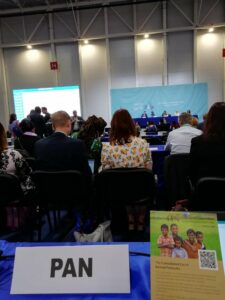Europäische Save the Bees Coalition fordert ein umfassendes Verbot von Neonikotinoiden
Presseinformation.
Hamburg, 5. Dezember 2017. Im Dezember 2013 hat die EU-Kommission entschieden, den Einsatz der drei hochgradig bienengiftigen Insektizide aus der Gruppe der Neonikotinoide Imidacloprid, Clothianidin und Thiamethoxam vorläufig zu beschränken. Zum 4. Jahrestag dieses Teilverbots belegt eine Vielzahl wissenschaftlicher Studien, dass das Teilverbot für die Anwendung dieser Insektizide in „für Bienen attraktiven Kulturen“ bei weitem nicht ausreicht, um Bestäuber ausreichend vor Vergiftungen zu schützen. 80 europäische Nichtregierungsorganisationen, die sich zur europäischen Save the Bees Coalition zusammengeschlossen haben, fordern die Mitgliedsstaaten daher auf, die Neonikotinoide endlich zu verbieten – ohne weitere Verzögerung und ohne Einschränkung.
Ein Regulierungsvorschlag der EU-Kommission, das Verbot auf alle Freilandkulturen auszuweiten, wird am 12 und 13. Dezember im zuständigen EU-Fachausschuss diskutiert und voraussichtlich den Mitgliedstaaten zur Abstimmung vorgelegt. Während Großbritannien, Irland und Frankreich bereits angekündigt haben ein strikteres Verbot zu unterstützen, haben andere Mitgliedsstaaten wie auch Deutschland ihre Position nicht veröffentlicht.
Der Vorschlag der EU-Kommission beruht auf den Schlussfolgerungen der Europäischen Behörde für Lebensmittelsicherheit EFSA, dass Bienen durch die Verwendung von Neonikotinoiden bei allen Freilandkulturen bedroht sind, und zwar nicht nur bei der Anwendungen in blühenden Nutzpflanzen, die sie direkt als Nahrungsquelle nutzen. Mehrere neue Studien belegen, dass Neonikotinoide die Umwelt kontaminieren und in Wasser und Wildblumen zu finden sind, wodurch auch Wildtiere gefährdet werden.
Rückbesinnung auf eine ökologisch verträgliche Landwirtschaft
„Die Entscheidung über das Verbot der hochbienengefählichen Neonikotinoid-Wirkstoffe wird zeigen, ob die Vertreter der Mitgliedstaaten endlich Verantwortung übernehmen und mit ihrer Zustimmung zum Neonikotinoid-Verbot zum Erhalt der biologischen Vielfalt und zur nachhaltigen Sicherung von Ernte-Erträgen beitragen.“ so Susan Haffmans von PAN Germany. „Statt immer wieder auf hochgefährliche Pestizide wie Clothianidin, Imidacloprid oder Glyphosat zu setzen, sollten die EU und ihre Mitgliedstaaten endlich ernsthaft die Weichen für nicht-chemischen Pflanzenschutz stellen und agrarökologische Anbaumethoden fördern.“
Imidacloprid wurde erstmalig 1994 in Frankreich zugelassen, zur Anwendung auf Sonnenblumen. Sofort bemerkten französische Imker, dass diese Chemikalien die Gesundheit ihrer Bienenvölker stark beeinträchtigten. Sonnenblumen-Felder waren eine Hauptquelle französischer Honigproduktion, doch jetzt wurden sie zu einem Motor für den Niedergang des französischen Imkerwesens. Die französischen Erfahrungen wiederholten sich in der EU und der ganzen Welt, als der Einsatz von Neonikotinoiden ausgeweitet wurde.
Nach 19 Jahren Mobilisierung durch Imker und Umweltschützer entschied die EU-Kommission 2013, den Einsatz hochbienengefährlicher Neonikotinoide in für Bienen attraktiven Nutzpflanzen zu verbieten. Außerdem verlangten die EU-Beamten von den Herstellern, Bayer und Syngenta, sogenannte „confirmatory data“ bereitzustellen, um die Toxizität der Stoffe besser einschätzen zu können. Die Europäische Behörde für Lebensmittelsicherheit (EFSA) wertete diese Daten aus und bestätigte im November 2016 (1), dass diese Substanzen hoch toxisch auf Bienen, Hummeln und Solitärbienen wirken. Die Behörde bestätigte auch, dass noch bestehende Datenlücken eine angemessene Risikoeinschätzung verhinderten, besonders für Wildbienen.
75 Prozent weniger Insekten in 30 Jahren
Die EFSA warnte auch davor, dass Bienen Neonikotinoiden auch außerhalb von Nutzpflanzen ausgesetzt sein könnten, da sich diese Insektizide schnell in der Umwelt verbreiten und Wildblumen kontaminieren. Unabhängige Studien haben darüber hinaus gezeigt, dass die Toxizität von Neonikotinoiden weit über Bienen hinausgeht: Hummeln, Wildbienen und Käfer sind im Verschwinden begriffen, wie gerade bestätigt wurde (75% weniger Insekten-Biomasse in Deutschlands Naturgebieten innerhalb von 27 Jahren (2)). Das „Worldwide Integrated Assessement on the Impact of Systemic Pesticides on Biodiversity and Ecosystems“ hat aktuell 500 wissenschaftliche Belege ausgewertet, die seit 2014 veröffentlicht wurden. Sie bestätigen: Neonikotinoide sind ein hohes Risiko nicht nur für Insekten, sondern auch für Wirbeltiere und Tier- und Pflanzenwelt überhaupt(3).
Mehr als 80 Nichtregierungsorganisationen, die den größten Teil der EU Mitgliedstaaten abdecken und Imker, Umweltschützer und Wissenschaftler umfassen, starten heute offiziell die Save The Bees Coalition (4), um zum Schutz unserer Umwelt das Neonikotinoid-Verbot zu erzielen. Die Koalition setzt sich dafür ein, dass alle EU-Mitgliedstaaten dem Vorschlag der Europäischen Kommission zustimmen, die Neonikotinoide Imidacloprid, Clothianidin und Thiamethoxam zum Schutz unserer Bienen zu verbieten und das Verbot auf die Anwendung in Gewächshäusern auszuweiten, da Gewächshäuser keine geschlossenen Systeme sind und Leckagen und Umweltverschmutzung nicht zu verhindern sind. Die Koalition wird auch fordern, dass alle anderen chemischen Pestizide ordnungsgemäß auf ihre Auswirkungen auf Bienen getestet werden, damit alle bienenschädigenden Pestizide in der EU zukünftig verboten werden. Daher müssen die Mitgliedstaaten das Bee Guidance Document der EFSA 2013 ohne Verzögerung annehmen (5).
Die Webseite der Save the Bees Coalition finden Sie hier: https://www.beecoalition.eu/
Mitglieder der Save the Bees Coalition Abella Lupa, APIADS, Apicultura de huesca, Apiscam, Apiservices, Arieco, Asociación Bee Garden, Asociación de apicultores de la Región de Murcia, Asociación Española de Apicultores, Asociación Galega de apicultura, Asociación Medioambiental Jara, Asociación RedMontañas, Asociación Reforesta, Avaaz, Baltic Environmental Forum Latvia, Bamepe, Bee Life European Beekeeping Coordination, Bijenstichting, Buglife, BUND, Campact, Confederación en Defensa de la Abeja en la Cornisa Cantábrica, Cooperativa El Brot, Division of Apiculture- Hellenic Agriculture Organisation DEMETER, Earth Thrive, Eco Hvar, ECOCITY, ecocolmena, Ecologistas en Acción, Estonian Green Party, European Professional Beekeepers Association, Federação Nacional dos Apicultores de Portugal, Federation of Greek Beekeepers‘ Associations, Foundation for the Environment and Agriculture, Friends of the Bees Foundation, Friends of the Earth Europe, Générations Futures, German Professional Beekeepers Association, Gipuzkaoko Erlezain Elkartea, Glore Mill Sustainability Centre for Biodiversity and Energy, Greenpeace, Inter-Environnement Wallonie, INLUISAL SL, Lithuanian Fund for Nature, Melazahar, NABU, Natur&ëmwelt, Nature & Progrès Belgique, Pesticide Action Network Europe, Pesticide Action Network UK, Pestizid Aktions-Netzwerk, proBiene, Quercus, Romapis, Salvem la Platja Llarga, Slovenian Beekeepers` Association, Slow Food, SOS polinizadores, Spanish Society of Organic Farming, Statera NGO, SumOfUs, Territorios Vivos, Umweltinstitut München, Unió de Llauradors I Ramaders, Union Nationale de l’Apiculture Française, Via Pontica Foundation, Vilde bier i Danmark, WECF France, WECF Germany, WWF España.
Medienkontakt
Susan Haffmans (PAN Germany): susan.haffmans[at]pan-germany.org, Tel: 040-3991910-25
(1) https://www.efsa.europa.eu/en/efsajournal/pub/4606
https://www.efsa.europa.eu/en/efsajournal/pub/4607
(2) Hallman et al. 2017
(3) https://www.iucn.org/news/secretariat/201709/severe-threats-biodiversity-neonicotinoid-pesticides-revealed-latest-scientific-review
(4) www.beecoalition.eu
(5) https://www.efsa.europa.eu/en/efsajournal/pub/3295


